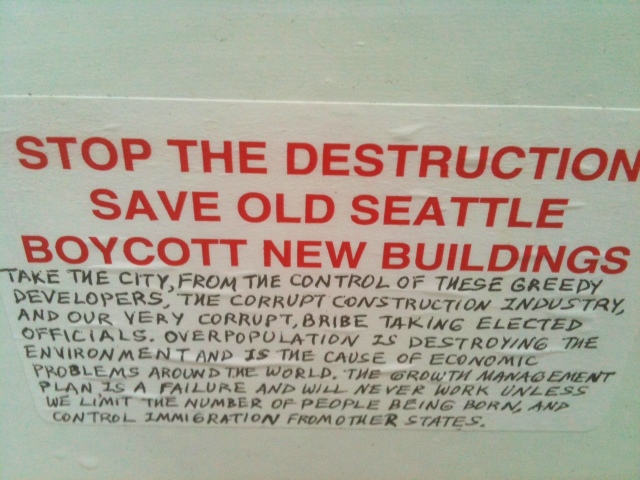Author’s note: I’ve been struggling about where to put this post. I think it is too speculative to put on the Smart Growth Seattle website, but I do think it’s time to start thinking through how Seattle shares the financial costs and risks of addressing housing for people who are poor. Generally speaking we should tax what we don’t want more of or inefficiencies; single-family neighborhoods are a less efficient use of land than dense multifamily neighborhoods. In my view we should allow more density in single-family neighborhoods, but undivided single-family lots should bear most of the tax burden to fund the housing levy. In the meantime, I am floating this idea. It’s long and wonky but I’m interested in anyone who has some thoughts about what I am looking at here. 
The question about whether Seattle has a workforce housing crisis has been answered. All available data indicates no scarcity of housing for people who earn 60 to 80 percent of Area Median Income (AMI). The data also indicate that the bigger need is at lower levels of income, below 60 percent AMI and the need is particularly acute for families.
And the so called incentive zoning program in Seattle isn’t really an incentive it is a fee, adding additional risk and cost to new development proposals making additional housing supply more challenging to achieve. Here’s what we know now:
- We shouldn’t be subsidizing people who earn 60 to 80 percent of AMI because the market is producing a surplus at these price points;
- The biggest ongoing need for housing subsidies are the hardest to finance projects which house people who earn less than 60 percent of AMI;
- The most acute need for help is for poorer families who need larger units in the city; and
- Incentive zoning just makes things worse by adding cost to housing production which lowers supply and makes all housing more scarce, especially for poor people.
So what’s the answer? What do we do? The answer may lie with Washington’s unique way of collecting property taxes and using Seattle’s housing levy to support financing of housing for our cities poorest families. How could we use our housing levy, a property tax that generates funds to help pay for housing with lower rents, to address the needs of poorer people without driving up the price of all housing in the city?
How are property taxes assessed and collected?
I studied our arcane tax system pretty extensively when writing about Tax Increment Financing (TIF). Our Constitutional requirement for “uniform” taxation makes TIF difficult to do. Washington State’s Constitution, Article VII, Section 1 states that,
All taxes shall be uniform upon the same class of property within the territorial limits of the authority levying the tax and shall be levied and collected for public purposes only. The word “property” as used herein shall mean and include everything, whether tangible or intangible, subject to ownership. All real estate shall constitute one class
To quote from my old article on TIF and the Constitution, that means that
The taxes that the city collects on . . . properties are NOT based on their assessed value. Those properties are taxed based on a rate set by the value of new construction throughout the city, the previous year’s city budget, and up to an additional [statutory] one percent of the previous year’s city budget. That rate is applied, equally per $1000 of value, to ALL properties across the city.
That makes Washington a budget based property tax state; that means that we don’t tax properties individually. A taxing district takes its last budget and levies property taxes on the total aggregate assessed value of the entire taxing district.
Here’s a super simple example. Let’s say you have a taxing district with $100,000,000 of assessed value and a budget for the district, let’s say it’s a town, of $10,000,000 that pays for police, fire and basic services. To keep it really simple, let’s say that there are only two property owners and one owner has an assessed value of $70,000,000.
| Total Assessed Value |
100,000,000 |
| Total District Budget |
10,000,000 |
| Rate per $100K of Value |
10% |
| Property A | $ 70,000,000.00 |
| Total Tax Bill | $ 7,000,000.00 |
In Washington, the rate is usually expressed as a whole dollar amount per $100,000 of value. People are used to hearing, “the levy will cost you about $10 per hundred thousand dollars of the assessed value of your home.” That allows tax payers to do the math. If my house has an assessed value of $250,000, I know my tax bill will be $25 a year.
This is different from an ad valorem property tax system which would tax individual properties at a set percentage of value. That kind of system would mean your total tax would be a percentage of its value rather than a share of the total assessed value of the whole district. It would also mean that your tax bill would always be calculated by simply multiplying the rate by the total value. Your taxes would always remain the same percentage of your properties value as it changed over time and would always go up as your property value increased.
Unusual effects of the budget based system
But in Washington our system allows for individual property tax bills to go down when overall assessed value of the district goes up, even when the total tax being levied goes up. Here’s how it would work in our simple example.
| Total Assesed Value | 110,000,000 |
| Total District Budget | 10,100,000 |
| Rate per $100K of Value | 9% |
| Property A | $70,000,000.00 |
| Total Tax Bill | $6,427,272.73 |
You can see that the assessed property value of all the property in the district went up by 10 percent, however Property A showed no increase in assessed value and it’s tax bill went down. The taxing district, our hypothetical city, increased it’s budget by the statutory allowable 1 percent, a limit set by the legislature (it’s notable that prolific initiative writer Tim Eyman’s limit 747 passed with voter approval setting this limit, but was thrown out by the State Supreme Court. A Democratic controlled legislature and Governor restored this limit).
How is it possible for the assessed value of all the property in the town to go up, for the town to ask for more money from tax payers, but for the owner of Property A to see his tax bill go down? Where does the extra money come from?
His neighbor.
Because the owner of Property B increased the value of his property by building apartments on it, for example, he boosted its value which increased the value of the whole district. But our owner of Property A left his property as a single-family home and its value didn’t go up.
| Total Assesed Value |
$110,000,000 |
| Total District Budget |
$10,100,000 |
| Rate per $100K of Value |
9% |
| Property B | $ 40,000,000.00 |
| Total Tax Bill | $ 3,672,727.27 |
You can see that the assessed value of Property B went up by $10,0000 and so did the assessed value of the whole taxing district, the town. Because of the improvements on Property B, the new apartments, the tax bill for Property B also increased by $672,727.27. Remember, the owner’s bill before would have been $3 million before the improvements and increase in the levy by the town.
New dense development and existing single-family neighborhoods can fund lower priced housing
If we increased total housing levy to subsidize housing for poorer people, new development could add more to the city’s assessed value generating more housing levy revenue. This would happen anyway since new projects add value to existing undeveloped property. Just like in our simple little example, properties that are improved with dense multifamily housing and commercial space would pay more in taxes while existing, undeveloped properties would pay less, the same, or only slightly more.
If we used the Housing Levy in Seattle this way we’d accomplish some important things that would enable us to
- Help finance housing for the poor,
- Support more housing supply and density,
- Tax inefficient use of land; and
- Preserve some single-family neighborhoods.
Instead of hitting developers with a tax (incentive zoning) that adds costs and risks to subsidize people who don’t need as much help—people earning above 60 percent of AMI—we could actually capture the value of the improvements developers are making, increase housing supply, generate revenue to subsidize lower priced housing, and promote development in areas that are primed for absorbing growth.
All this benefit would come from increases to the housing levy paid by new development and single-family home owners. The new contributions to lower priced housing would be paid by all property owners in the city, not just fees on additional square footage or FAR. At first that sounds politically crazy. Who’d campaign on raising taxes on Seattle’s single-family neighborhoods?
Well at first it sounds that way, but when you consider how we do property taxes, single-family home owners would see their taxes stay pretty much the same while development increased in other parts of the city. Additionally, many of Seattle’s progressives could point to the new funds being generated for lower priced housing from an increased levy.
We would also be doing the right thing: taxing people with equity in single-family homes to help offset the real challenges faced by poor people struggling to pay rent and find adequate housing options. Developers would pay more because of improvements and single-family homeowners would share some of the cost too because they’d benefit from having density go somewhere else. Using our state’s peculiar way of collecting property taxes could be a fair, efficient, and progressive way of addressing the needs of the poor while promoting growth, jobs, and more housing choices.
Important caveats and provisos
Make no mistake, we still need more infill development in single-family neighborhoods; we need all kinds of options including for people who want to have the choice to live in small-lot housing, cottages, and accessory dwelling units.
This would require the City Council to rapidly and completely deregulate the housing market in Seattle. It means we’d have have something very close to Zero Based Zoning, which would allow building up to whatever the limits of financing, not height, bulk, scale or aesthetics.
The housing levy would rise significantly and people and businesses could feel a pinch. The new tax would be more fair and would likely be paid largely by single-family tax payers since most land in Seattle is single-family. The City would have to be careful not to set the levy too high since it could increase risk on improvements to property that could act as a disincentive on new construction.
More taxation to help financing housing for poorer people adds risks and costs, but if we do it right that risk is shared between new growth (multifamily and commercial development) and old growth (single-family homeowners).
As a matter of principle, taxes should be on things we don’t want not things we want more of. This entire scheme might be politically expedient, but it does increase taxes on what we want more of which is improvement of land. We should actually be doing the opposite, taxing underdeveloped property to fund lower priced housing not new development. However, that idea, taxing the inefficient use of land by parking big houses on big lots is probably truly politically impossible today.
We must find the smarts and political will to amend Washington’s Constitution to allow Tax Increment Financing which would allow true value capture to create new money to pay for infrastructure and, possibly, subsidize the construction of lower priced housing.









